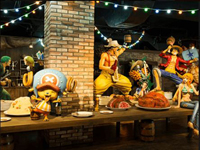Fushimi Inari Taisha


(Source: Hick / PIXTA(ピクスタ))
Senbon Tori
The biggest spectacle of the site is “Senbon Torii” (thousands of gates) that cascade up from the main hall. The word thousand is traditionally used rhetorically to mean “countless” in Japanese but the actual number of tori even surpasses a thousand, apparently reaching as many as 10,000. Countless vermillion-colored torii densely aligned one after another look like a tunnel leading into another world and exhibit a dream-like quality. Each tori is financed by a donation and inscribed with the donor’s name. Traditionally, the donation of tori is an act of showing one’s appreciation to the shrine for having his/her wish come true, so it demonstrates how effective the shrine’s divine power has been.

(Source: https://pixta.jp/photo/11924201)
Honden
Honden, the main hall, comes into view as you pass under its entrance gate. The majestic building painted in red is registered as a national important cultural property and it has an overpowering presence. The entire building was damaged in the fire in 1468 but was since rebuilt in 1499.

(Source: pixta)
Rou-mon
Immediately after the first big tori, which is the entrance to the whole premises, appears a vermillion-lacquered tower gate donated by Hideyoshi Toyotomi in 1589. It is the largest in size among gates leading to a shrine in Japan. The vivid, vermillion observed everywhere in this shrine is known to keep evil spirits away and depicts the divine power of the god residing here.

(Source: コチ / PIXTA(ピクスタ) )
Fox-shaped ema
Ema (small wooden plaques for prayers) available at shrines and temples in Japan typically come with a picture of a horse and the visitor writes his/her wish on the back. However, at Fushimi Inari Taisha, they come in the shape of a fox, an animal known to be the messenger for the deity of Oinari-san. Its face is left blank for you to draw as you like. Make a fun memory of your trip by drawing a nice-looking fox while making your wish.

(Source: ハク / PIXTA(ピクスタ) )
Walking trails
There are numerous tori and stone steps on the trail. Combined with a contrast between the natural green and red of torii, it creates a beautiful path. You will be greeted by a sequence of interesting scenes, both beautiful and unique, thanks to Otsuka (a group of stone monuments), small shrines and mini-tori seen along the way.

(Source: ミッキー / PIXTA(ピクスタ) )
Feel spiritual at various spots
In the mountain, you will find a space that is otherworldly and mystical here and there – be it miniature tori piled together, small waterfalls and wells, or an enshrined god who protects worshipper’s health such as their eyes, back and throat. Here, you can enjoy a fascinating walk like no other.

(Source: じょにー / PIXTA(ピクスタ) )
Foxes
Everywhere on the grounds are multitudes of fox statues. They often have an ear of rice, a scroll, a key, or a ball in their mouths, each symbolizing the god of rich harvest, intellect, business prosperity and so on.

(Source: ののさんのひとり言)
Senbon Tori at night
Senbon Tori looks even more surreal at night. During the festival period, which falls in every July, lanterns are hung, coloring the shrine a burning red against the darkness of the summer nights. Nothing gets more otherworldly than this.

(Source: TAKUYA.A / PIXTA(ピクスタ) )
Barbeque of sparrows and quails
Fushimi Inari Taisha is also known to serve a barbeque of sparrows and quails, grilled whole. It is said to originate from the local residents’ attempt in the old days to exterminate the sparrows, natural enemies of the rice field during harvest. How about challenging yourself to try one?

(Source: Twitter)

(Source: Hick / PIXTA(ピクスタ))
Senbon Tori
The biggest spectacle of the site is “Senbon Torii” (thousands of gates) that cascade up from the main hall. The word thousand is traditionally used rhetorically to mean “countless” in Japanese but the actual number of tori even surpasses a thousand, apparently reaching as many as 10,000. Countless vermillion-colored torii densely aligned one after another look like a tunnel leading into another world and exhibit a dream-like quality. Each tori is financed by a donation and inscribed with the donor’s name. Traditionally, the donation of tori is an act of showing one’s appreciation to the shrine for having his/her wish come true, so it demonstrates how effective the shrine’s divine power has been.

(Source: https://pixta.jp/photo/11924201)
Honden
Honden, the main hall, comes into view as you pass under its entrance gate. The majestic building painted in red is registered as a national important cultural property and it has an overpowering presence. The entire building was damaged in the fire in 1468 but was since rebuilt in 1499.

(Source: pixta)
Rou-mon
Immediately after the first big tori, which is the entrance to the whole premises, appears a vermillion-lacquered tower gate donated by Hideyoshi Toyotomi in 1589. It is the largest in size among gates leading to a shrine in Japan. The vivid, vermillion observed everywhere in this shrine is known to keep evil spirits away and depicts the divine power of the god residing here.

(Source: コチ / PIXTA(ピクスタ) )
Fox-shaped ema
Ema (small wooden plaques for prayers) available at shrines and temples in Japan typically come with a picture of a horse and the visitor writes his/her wish on the back. However, at Fushimi Inari Taisha, they come in the shape of a fox, an animal known to be the messenger for the deity of Oinari-san. Its face is left blank for you to draw as you like. Make a fun memory of your trip by drawing a nice-looking fox while making your wish.

(Source: ハク / PIXTA(ピクスタ) )
Walking trails
There are numerous tori and stone steps on the trail. Combined with a contrast between the natural green and red of torii, it creates a beautiful path. You will be greeted by a sequence of interesting scenes, both beautiful and unique, thanks to Otsuka (a group of stone monuments), small shrines and mini-tori seen along the way.

(Source: ミッキー / PIXTA(ピクスタ) )
Feel spiritual at various spots
In the mountain, you will find a space that is otherworldly and mystical here and there – be it miniature tori piled together, small waterfalls and wells, or an enshrined god who protects worshipper’s health such as their eyes, back and throat. Here, you can enjoy a fascinating walk like no other.

(Source: じょにー / PIXTA(ピクスタ) )
Foxes
Everywhere on the grounds are multitudes of fox statues. They often have an ear of rice, a scroll, a key, or a ball in their mouths, each symbolizing the god of rich harvest, intellect, business prosperity and so on.

(Source: ののさんのひとり言)
Senbon Tori at night
Senbon Tori looks even more surreal at night. During the festival period, which falls in every July, lanterns are hung, coloring the shrine a burning red against the darkness of the summer nights. Nothing gets more otherworldly than this.

(Source: TAKUYA.A / PIXTA(ピクスタ) )
Barbeque of sparrows and quails
Fushimi Inari Taisha is also known to serve a barbeque of sparrows and quails, grilled whole. It is said to originate from the local residents’ attempt in the old days to exterminate the sparrows, natural enemies of the rice field during harvest. How about challenging yourself to try one?

(Source: Twitter)






